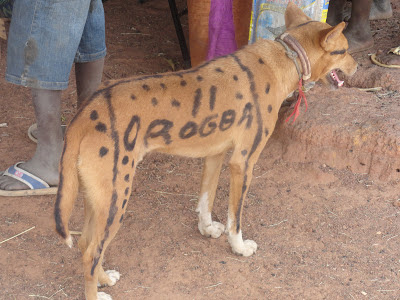On Friday, I will begin a five-day bike tour in western Benin with seven other volunteers. We will be biking from community to community to share information about malaria. I would like to take this opportunity to share a little about malaria with you.
Malaria is one of the most serious health problems in sub-Saharan African, yet Americans seem to have a single-minded focus on AIDS when thinking about African health (in Benin, only 1-2% of the population has HIV/AIDS). In Benin, malaria represents 40% of the cases treated in health centers. Worldwide, 300-500 million people contract malaria each year and 1.5-2.7 million die of it. Malaria is such a serious problem in Benin that all Peace Corps volunteers here, including non-health ones, are expected to conduct malaria activities.
People contract malaria when bitten by a specific type of mosquito that is carrying the disease. The most characteristic symptom is fever, which gets exaggerated to the point where many Beninese, including some health agents, just assume any fever is malaria.
As volunteers, there are a number of angles from which to approach malaria prevention. For starters, many Beninese do not know that mosquitoes cause malaria. Some believe that the sun or consuming too much oil can also cause it. Once the connection between mosquitoes and malaria is established, we can offer strategies to prevent mosquito bites.
The most popular prevention tool is insecticide-impregnated mosquito nets. Every family received government-donated mosquito nets a few years ago, and health centers may also have a supply to give away (though many health centers have run out). However, some families have repurposed their mosquito nets (for fishing nets, drying tomatoes, fences, etc), and others don't know how to use them effectively. Part of our role is to teach the how and why.
Nets alone are not enough to prevent malaria. For those evening hours before the family members are safely tucked under their mosquito nets, we can teach them how to make neem cream, a homemade insect repellant. The active ingredient is the leaves of the neem tree, which is readily found in Benin. The leaves are boiled with water, then the leaves are strained out and the neem water is mixed with soap shavings and oil. The final product is rubbed into the skin like a moisturizer.
In addition to avoiding bites, we can also teach families how to reduce the mosquito population around their homes. Mosquitoes lay eggs in stagnant water, so water receptacles should be covered and items that may inadvertently collect water (like old tires, discarded cans, etc) should be removed. Because of the connection with water, peak malaria season is during the rainy season, which is May to November in the North. Unfortunately, the onset of malaria season does not align with the hospitable season for biking, so our bike tour falls during the dry season.

























